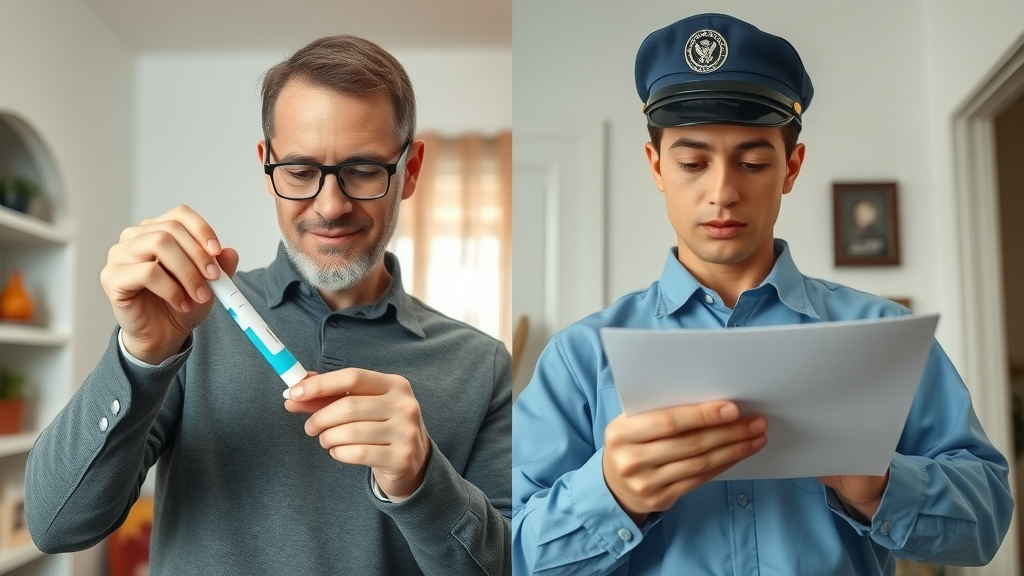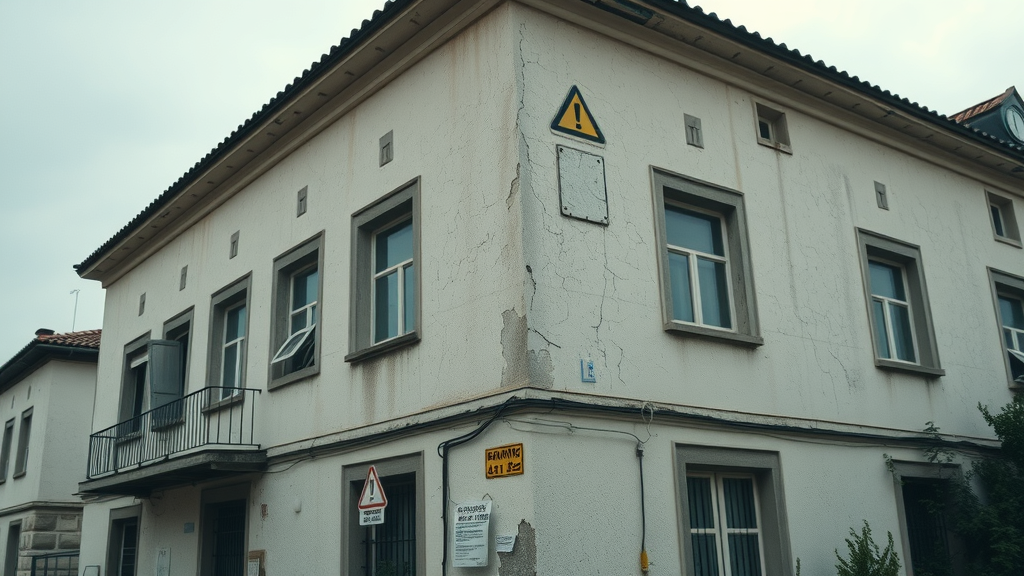“Exposure to asbestos still causes over 39,000 deaths annually in the US alone. Rapid and reliable asbestos contamination testing is essential for ensuring safety and peace of mind.”
Did you know that exposure to asbestos remains one of the leading causes of preventable diseases, accounting for over 39,000 deaths every year in the US alone? Asbestos contamination testing is not just a regulatory requirement—it’s a proactive step in protecting the health of your family, workers, and the longevity of your property. Understanding the process, challenges, and urgency of asbestos testing empowers you to make informed decisions, safeguard your air quality, and avoid long-term health hazards like lung cancer and asbestosis. If you own or manage a residential or commercial building, this guide is essential reading—discover actionable steps, practical examples, and industry best practices for accurate and rapid asbestos test results.
Why Asbestos Contamination Testing Matters for Your Safety and Health
- Understanding the alarming risks of asbestos exposure
- The critical importance of prompt asbestos contamination testing
- How asbestos testing protects air quality and reduces health hazards
Asbestos contamination testing is crucial because it directly impacts both your immediate health risk and long-term wellbeing. When asbestos-containing materials are disturbed—during renovations, demolition, or even routine maintenance— asbestos fibers can be released into the air. Inhaling these airborne asbestos fibers poses severe risks, including lung cancer , mesothelioma, and asbestosis. The danger isn’t restricted to industrial settings; older residential buildings, schools, and commercial facilities can all harbor hidden asbestos hazards. Being proactive with asbestos testing can be the difference between early intervention and irreversible exposure.
Fast and reliable asbestos testing is also vital for maintaining good air quality indoors, especially in environments where vulnerable people—children, the elderly, or those with pre-existing health conditions—are present. Prompt asbestos contamination testing ensures that asbestos dust does not compromise your environment, giving you peace of mind and compliance with safety and health regulations. By understanding and acting on the importance of asbestos tests, you protect not only your property but the public health at large.

What is Asbestos Contamination Testing? (asbestos test Explained)
Asbestos contamination testing is the process used to identify and quantify the presence of asbestos fibers within construction materials, dust, or air inside buildings. This methodical approach involves strategic sampling , laboratory analysis (often with polarized light microscopy ), and a detailed report of findings. The goal is to determine whether a building material or area represents a health hazard to occupants and workers, and to support compliance with environmental protection agency guidelines.
Accurate asbestos testing reveals the type and concentration of asbestos fibers , allowing property owners to take informed actions—ranging from remediation to ongoing monitoring. Testing is a vital first step before any renovation or demolition project, as it can prevent the unnecessary spread of airborne asbestos fibers and reduce asbestos hazard exposure risks. If you suspect or know that your property contains materials from the 20th century, regular testing for asbestos contamination is advised.
Types of Asbestos and Their Health Hazard Implications
There are several types of asbestos that can be found in buildings, including chrysotile (white asbestos), amosite (brown asbestos), and crocidolite (blue asbestos). Each variety of asbestos presents a unique risk: some fibers are curly and less likely to become airborne, while others are needle-like and can easily become lodged in the lungs if inhaled. The health hazard linked to these materials stems from the body's inability to break down or expel asbestos fibers—once inhaled, they persist.
All types of asbestos can cause serious health issues, but crocidolite and amosite are particularly dangerous because of their higher resistance to chemical and biological breakdown, making them more likely to lead to aggressive diseases such as lung cancer and mesothelioma. Accurate asbestos contamination testing will identify which specific type of fibers are present, helping to guide both remediation strategies and safety and health protocols. Knowing the individual fiber type is crucial for assessing risk and ensuring appropriate protective measures.
Proper identification through an asbestos test also informs the selection of containment, removal, or encapsulation techniques to minimize the release of fibers into the air and thus mitigate the potential for exposure. Property owners and managers, particularly in older or industrial buildings, should be aware that multiple types of asbestos may coexist in flooring, insulation, roofing, and other building materials , necessitating a thorough approach to testing and risk assessment.

Identifying Areas Prone to Asbestos Contamination
Not every area in a building is equally at risk for asbestos contamination . Common sources include old insulation, ceiling tiles, floor tiles, roofing materials, external cladding, and around hot water pipes. Structures built or renovated before the 1990s are at a significantly higher risk, as asbestos use was popular and largely unregulated before this period. Homeowners and property managers need to be especially cautious in residential buildings and schools, where even minor damage or disturbance can release dangerous fibers into the air.
Prone areas also include basements, attics, boiler rooms, and any location with visible signs of building material wear, such as cracked paint, crumbling insulation, or deteriorating tiles. Asbestos dust may accumulate invisibly, so relying solely on visual inspection is risky. Engaging professional asbestos testing is the only reliable way to identify asbestos fibers and ensure comprehensive safety measures are enacted before renovations, demolitions, or repairs.
In multi-tenant dwellings or commercial settings, policy may require regular or preemptive asbestos contamination testing, especially in high-traffic or high-vulnerability areas. Proactive identification protects building owners against legal liability and helps maintain a safe environment, supporting both compliance and peace of mind for all occupants.
The Asbestos Testing Process: Steps to an Accurate Asbestos Test
Reliable asbestos testing follows a structured process, moving from safe sample collection to advanced laboratory evaluation and finally, clear reporting. Each step must meet industry and regulatory standards to ensure results are legally defensible and truly reflect potential airborne asbestos hazards. Here’s a look at each critical phase in ensuring a successful asbestos contamination testing outcome.
Missing just one element of this process can mean undetected asbestos hazard exposure. That’s why both DIY and professional testing must adhere to recognized safety protocols, from proper sample acquisition to the laboratory’s analytical methods, such as polarized light microscopy . Quality assurance at every stage safeguards your property and the people who live or work in it.
Sampling: How to Test for Asbestos Safely
The sampling stage is the foundation of any accurate asbestos test . A certified technician—or well-instructed homeowner, in less risky circumstances—carefully collects material from suspected contaminated areas while minimizing disruption and preventing the release of asbestos dust . This usually involves dampening the material, sealing off the sample zone, and using personal protective equipment such as masks and gloves to avoid direct exposure.
Collected samples are then sealed in specialized containers, labeled, and sent to an accredited laboratory for analysis . Mistakes during sampling can compromise the entire process, potentially exposing people to airborne asbestos fibers and yielding inconclusive results. It’s crucial to follow each step with precision, whether you opt for DIY or professional sample collection.
Always follow local regulations and consider engaging a certified asbestos contractor for higher-risk or hard-to-reach areas. The safety and accuracy of the asbestos test depend largely on how well the sampling phase is performed.

Laboratory Analysis: Methods Including Polarized Light Microscopy
Once samples arrive at the lab, professionals use state-of-the-art methods such as polarized light microscopy (PLM) and, if necessary, transmission electron microscopy (TEM) to identify asbestos fibers . The use of polarized light allows scientists to distinguish asbestos from other mineral fibers based on optical properties. This detailed analysis determines the presence, type, and concentration of asbestos fiber within the sample.
Results from these tests are quantifiable—indicating exactly how many fibers are present per gram of material or per cubic meter of air. This scientific rigor ensures that decisions regarding remediation, removal, or ongoing monitoring are grounded in precise air quality data and meet the standards set by the environmental protection agency . Comprehensive lab analysis is critical for distinguishing between safe and hazardous conditions in your property.
Laboratory for analysis is a non-negotiable step; at-home test kits without professional validation can yield unreliable or even dangerous outcomes. Always confirm that the laboratory is accredited and uses current, approved analysis methods for the safest possible environment.
Quality Assurance and Reporting Asbestos Contamination Results
After analysis, the laboratory provides a detailed, legally recognized report documenting the types, concentration, and locations of asbestos fibers found. These reports should include photographs, sampling locations, specific analytical methods (like polarized light ), and a thorough breakdown of results understandable to both experts and laypersons.
Quality assurance is fundamental; reputable labs have procedures in place to prevent cross-contamination, verify results through repeat testing, and uphold strict data integrity. Accurate reporting closed the loop, giving building owners and managers the information needed to comply with regulations, communicate findings to stakeholders, and make informed decisions about remediation or further monitoring.
Detailed asbestos contamination testing results are often required by legal authorities or insurance agencies—especially if demolition, sale, or transfer of property is involved. Choosing accredited testing and analysis providers with transparent, clear reporting ensures both safety and peace of mind.
How to Check for Asbestos Contamination: Practical Guide
Checking for asbestos contamination requires a clear plan: identify high-risk zones, decide between DIY kits and professional services, and always prioritize staff and resident safety. Your options will vary based on the scale of the project, material accessibility, and regulatory requirements in your area.
The following guide compares do-it-yourself asbestos test kits with comprehensive professional services, and explains ongoing air quality monitoring as an essential strategy for identifying airborne asbestos exposures before health risks escalate.
DIY vs. Professional Asbestos Contamination Testing: Pros and Cons
Many homeowners are tempted to use DIY asbestos test kits for convenience and lower upfront cost. These kits provide instructions for safely collecting samples and mailing them to a lab. While this approach can be adequate for very limited or clearly accessible areas, it carries a health risk —especially if asbestos fibers are disturbed or the sampled material is friable.
In contrast, professional asbestos testing offers far greater accuracy and safety. Certified technicians possess the right protective equipment, extensive training, and—most importantly—an understanding of all likely building material sources. Professional asbestos test providers ensure correct sampling, minimize exposure, and provide results that stand up to legal scrutiny and compliance checks.
Ultimately, for full property surveys (and any suspected high-density contamination), professional assessment is recommended. DIY kits may be useful for peace of mind in small, localized scenarios, but never substitute for comprehensive, accredited sampling and lab work.

Air Quality and Monitoring: Assessing Asbestos Exposure Risk
Monitoring air quality for airborne asbestos fibers is vital in environments where past, unrecorded contamination is likely, or where ongoing works may disturb suspect materials. Specialized air pumps draw a measured quantity of air through a fine filter, capturing even an individual fiber for assessment. The airborne asbestos concentration is then measured to assess the current risk of inhalation and to guide next steps in exposure reduction.
Consistent monitoring is especially valuable in schools, hospitals, or commercial buildings with aging infrastructure. If levels exceed the environmental protection agency 's threshold, immediate action—including area evacuation or professional remediation—is essential to reduce health risks. Regular air quality assessment complements periodic material sampling, offering a real-time snapshot of health hazard potential.
Incorporating both environmental and building material testing into your maintenance routine is a proven way to prevent long-term health hazards and protect both property value and occupant well-being.
When and Why You Should Test for Asbestos Exposure
Understanding when and why to initiate asbestos contamination testing can make all the difference in preventing medical and legal complications. If your property was built before the 1990s or shows signs of material contains asbestos , immediate testing is recommended before disturbance. Certain events—such as leaks, fire, renovations, or unexplained respiratory symptoms among occupants—are strong indicators that asbestos fibers may already be present in dangerous concentrations.
Proactive asbestos tests are mandated in many regions before commencing any major construction or demolition projects. Even smaller-scale repairs in older properties can release invisible asbestos dust, making regular or situational testing a wise investment in public health .
Recognizing Signs of Potential Asbestos Exposure
Physical signs that warrant immediate asbestos testing include visible damage to wallboard, insulation, floor or ceiling tiles, or pipe laggings—especially if these are original materials in structures built before 1990. In addition, unexplained dust accumulation that doesn’t match usual household dust, or an increase in respiratory symptoms such as persistent cough, shortness of breath, or chest tightness among occupants, may indicate exposure to airborne asbestos fibers .
If property documentation or renovation records are unclear, and you are unable to positively identify asbestos -containing materials, err on the side of caution and arrange for professional assessment. Consistent or recent construction in the neighborhood can also contribute to cross-building contamination, making vigilance and frequent checks necessary.

Who Needs Asbestos Testing and How Often?
Building owners , landlords, property managers, and homeowners are all responsible for ensuring their assets are free from asbestos hazard. High-risk groups, including occupants of older homes, schools, hospitals, and commercial sites built before the 1990s, should schedule asbestos testing at regular intervals or whenever disturbance of building materials is planned.
For those managing properties with frequent tenant turnover, or in compliance-heavy sectors, annual or biennial testing is recommended. Even in newer buildings, testing should be triggered by unexplained dust, renovations, or after significant damage such as flooding or fire. Ensuring that asbestos contamination testing is a routine consideration helps create healthier, more resilient environments for everyone.
Regulatory requirements may also mandate testing for specific sectors and property types, so always check your local environmental protection agency’s guidelines to stay ahead of compliance.
Regulations and Safety Standards in Asbestos Contamination Testing
Strict regulations govern the execution of asbestos contamination testing , reflecting the substance’s status as a class 1 health hazard . Compliance with regional, national, and international safety standards not only protects against asbestos hazard exposure but is also crucial for avoiding legal and financial consequences.
Following all required protocols ensures you address potential environmental liability issues while contributing to larger public health goals. Knowing the rules helps you select the right partners and guarantees the information you receive will stand up to scrutiny.
Legal Requirement for Asbestos Tests in Australia
In Australia, the law is crystal clear: building owners and employers are required by occupational health and safety legislation to conduct asbestos testing before any demolition, renovations, or repairs. The environmental protection agency prescribes standards for asbestos identification, containment, removal, and disposal. Failure to comply can lead to heavy fines, work stoppages, and even criminal liability, especially if public health is endangered due to negligence.
Beyond legal obligations, workplace health and safety regulators demand documented proof of asbestos test results. This is particularly important in industries with significant risk of asbestos exposure , such as construction, manufacturing, or education. Keeping regular, up-to-date asbestos contamination testing records is both a legal necessity and a best practice for all stakeholders.
Health and Safety Protocols: Mitigating Health Hazards
Mitigating asbestos hazards starts with strict adherence to safety and health protocols during every phase of asbestos contamination testing. This means using regulated sampling methods, proper containment and cleanup, exhaust ventilation, air quality monitoring, and PPE—all in accordance with work health and safety policies.
Property owners, tenants, and contractors must be notified in advance of planned testing, and steps taken to minimize the risk of fiber release. Immediate isolation of the affected area, coupled with wet methods to suppress asbestos dust , minimizes airborne exposure. After testing, an effective decontamination process for equipment and workers must follow. Only then can you safely proceed with any further building work or occupancy.
Regular training, clear signage, and continuous air quality assessment are among the best strategies to ensure ongoing protection for all building users and to comply with current environmental protection agency and occupational regulations.
Choosing an Asbestos Testing Provider: What to Look For
Selecting the right provider for asbestos contamination testing helps guarantee both accuracy and speed. Don't compromise on experience or credentials—your family's health, compliance with safety laws, and potential resale value may depend on it. Evaluate providers using these criteria.
Ultimately, the provider’s reputation and turnaround times should be matched with transparent documentation and rigorous scientific procedures. Doing your due diligence ensures both the reliability and efficiency of your asbestos test process.
Key Credentials and Certifications for Asbestos Test Providers
Always ensure your chosen testing service is fully accredited and employs certified asbestos professionals. Reputable providers are registered with regulatory authorities, follow industry best practices, and are regularly audited for compliance with international and local standards. Certification assures that sampling, testing, and reporting are valid and actionable.
Inquire about insurance coverage, previous project experience, and whether they possess up-to-date training relating to the latest testing technologies and public health policy developments. The right certifications help protect against liability and ensure findings are recognized by environmental protection agencies, insurers, and property sale authorities.
Professional organizations like the Australian Institute of Occupational Hygienists or the National Association of Testing Authorities (NATA) are good benchmarks for independent assessment and accreditation.
Reviewing Customer Results and Response Times
Quick turnaround is vital in asbestos contamination testing —especially if you are facing urgent repairs, legal deadlines, or health emergencies. Leading providers typically offer initial results within 24 to 72 hours for standard material or air quality tests, followed by comprehensive reports.
Review customer feedback for reliability, clarity of communication, and post-report support. Transparent, customer-centric providers are more likely to respond to urgent requests and deliver clear guidance on next steps, no matter what the results of the asbestos test reveal.
Selecting providers with proven track records in customer satisfaction and accurate, timely reporting helps minimize disruption and ensures safe, compliant outcomes.
How Much Does It Cost to Have an Asbestos Test Done?
| Service Type | Average Price (AUD) | Turnaround Time |
|---|---|---|
| Single Sample (Material) | $90 – $150 | 24–72 hours |
| Air Quality Test | $250 – $500 | 1–3 days |
| Comprehensive Property Survey | $500 – $1200+ | 2–5 days |
| Emergency/Same-day Service | Varies (typically additional 15–25%) | Same day |
Note: Pricing may vary depending on building size, accessibility, urgency, and the volume of samples required. Be sure to ask for a detailed quote and verify what is included—such as the cost for lab analysis, travel, or expedited reporting—before committing to a provider.
Frequently Asked Questions about Asbestos Contamination Testing
-
How can you test for the presence of asbestos?
Testing begins with careful sampling of suspected materials by a trained professional or via an accredited DIY kit. These samples are then sent to a laboratory for analysis using methods such as polarized light microscopy. Self-inspection is not recommended due to the risk of disturbing asbestos fibers and causing airborne exposure. -
Can you get a test for asbestos exposure?
Medical tests do not directly measure exposure to asbestos fibers, but a doctor can use chest X-rays and lung function tests to assess early signs of asbestos-related diseases. Testing your environment for airborne asbestos fibers or contaminated dust is more effective for identifying immediate risks. -
How to check for asbestos contamination?
Visually inspect areas for old or degraded building materials, but always use professional asbestos contamination testing for certainty. This involves hands-on sampling, laboratory analysis, and clear, detailed reporting of results before pursuing any renovation or repair. -
Is asbestos contamination common in older buildings?
Yes, buildings constructed or renovated before the 1990s commonly contain asbestos in insulation, ceilings, flooring, and pipework. Regular asbestos testing is highly recommended for such properties, especially if they show signs of wear or require repairs. -
What to do if asbestos contamination is confirmed?
If asbestos contamination is found, restrict access to the area, notify all occupants, and consult a licensed asbestos removalist. Professional abatement, proper disposal, and post-removal air quality checks are required before the space can be safely reoccupied.
Best Practices: Ensuring Reliable and Timely Asbestos Contamination Testing
- Always use accredited asbestos testing services
- Request clear, documented lab results
- Monitor air quality consistently in high-risk areas
- Follow all safety and health protocols
By consistently applying these best practices, homeowners and building managers maximize the reliability of their asbestos contamination testing results while demonstrating commitment to safety, compliance, and public health.
Ensuring timely action, clear communication, and strict adherence to protocol is the only way to effectively manage asbestos hazard risks and protect the people and property you care about.
Summary: Rapid Asbestos Contamination Testing for Safer Environments
Act fast, stay informed, and always trust accredited asbestos test professionals—because peace of mind starts with a single, accurate test for asbestos.
“Don’t leave your safety to chance—timely asbestos contamination testing can protect your health and the future of your property.”
Contact Certified Asbestos Test Experts Today
- Get Your Asbestos Test in 24 Hours - Call +61 489 263 599 or email quote@asbestostestingnewcastle.com.au for instant support and peace of mind.
Take actionable steps: book professional asbestos contamination testing, review your legal obligations, and ensure ongoing air quality for a healthier home and community.
Ensuring the safety of your environment through accurate asbestos contamination testing is paramount. For a comprehensive understanding of the testing process, including methods like Polarized Light Microscopy (PLM) and Transmission Electron Microscopy (TEM), refer to the article “ Asbestos Testing: Products, Methods, and the Importance of Laboratory Testing .” This resource details the significance of laboratory analysis in identifying asbestos fibers and emphasizes the necessity of professional testing to maintain health and safety compliance.
Additionally, the article “ Asbestos in Homes | Who Can Safely Test & Remove It? ” provides essential guidance on the risks associated with asbestos in residential settings. It underscores the importance of engaging certified professionals for testing and removal, highlighting the dangers of DIY approaches and the critical steps homeowners should take if they suspect asbestos presence.
By consulting these authoritative sources, you can gain valuable insights into the procedures and precautions necessary for effective asbestos contamination testing, ensuring the safety of your property and its occupants.
 Add Row
Add Row  Add
Add 




Write A Comment